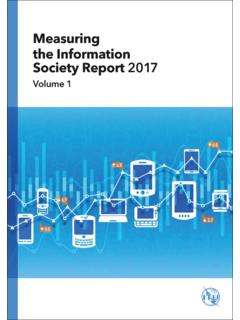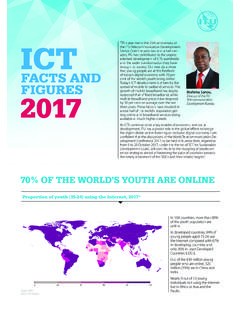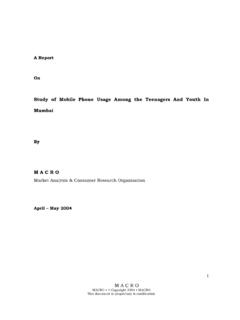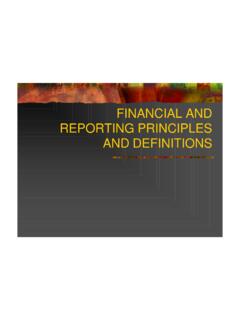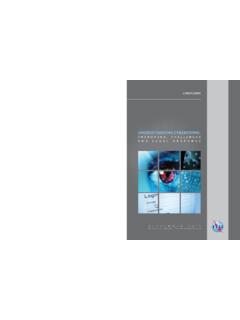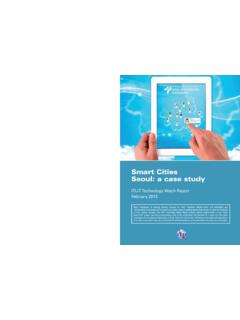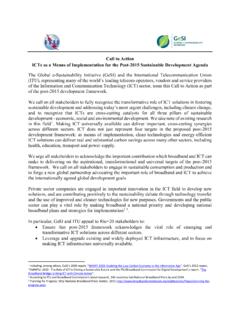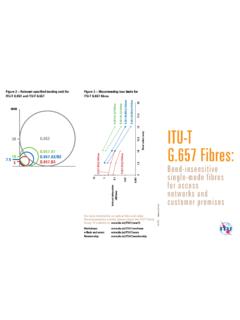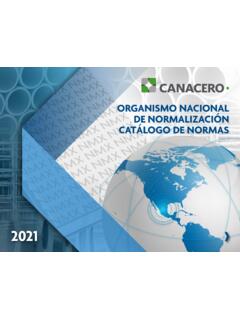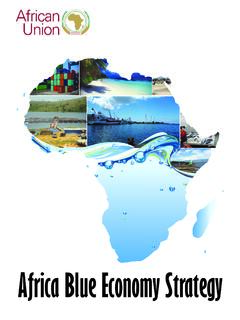Transcription of Telecommunication Technologies and Network Development ...
1 Telecommunication Technologies and Network Development Division Our mandate The Technology and Network Development Division, under Objective 2/2 Telecommunication /ICT. networks, including conformance and interoperability and bridging the standardization gap, provides applied research and transfer of technological know-how, which is an indispensable part of the task of expediting the access to new Technologies on a non-discriminatory basis for developing countries and countries with economies in transition. What we do for our members We assist Member States and ITU-D Sector Members and Associates to maximize the utilization of appropriate new Technologies for the Development of their information and communication infrastructure and services.
2 We also assists Member States and ITU-D Sector Members and Associates to plan, build, operate, upgrade, manage and maintain Technologies applicable in their networks and services. This includes the Development of the Telecommunications and Information infrastructure and applications Internet Exchanges and the Transition from IPv4 to IPv6. For more information: Telecommunication Technologies and Network Development Division Key activities Projects in focus Our work is carried out by various means, including symposia, workshops, conferences, seminars and expert advice as well as information sharing, creation of tools and training material, direct assistance, partnership, publications and events.
3 Our priority areas are as follows: Next Generation Broadband Rural Networks Mobile Networks Communications Communications Next Generation Networks Conformity and Interoperability Assessment Study on Regional Basis: Conformity and Interoperability Collaboration with Regional and Subregional Organizations for establishing a Mobile Communications common C&I Regime and Mutual Recognition Agreements Broadband Networks Training Activities on Conformance and Interoperability Rural Communications ITU-McCaw Foundation Broadband Wireless Network Project for Africa WSIS Action Line C2: Information ITU Interactive Transmission Map and Communication Infrastructure Telecommunication Technologies and Network Development Division Key Areas Products and Services in Focus Our work is carried out by various means, including symposia, workshops, conferences, seminars and expert advice as well as information sharing, creation of tools and training material, direct assistance, partnership, publications and events.
4 Our priority areas are as follows: Next Generation Mobile Conformity and Broadband Rural Networks Communications Interoperability Networks Communications Next-Generation Networks: assistance on planning, deployment, migration, ITU Guidelines on Conformity and Interoperability: Different Guidelines relating to interoperatbility, digitization and evolution of networks, Network elements and best practice for planning and review of C&I regimes, Mutual Recognition applications Agreements, establishment of C&I Test Labs and others Broadband Networks (wired and wireless Technologies including IMT): assitance with ITU Trainings on C&I.
5 Provision of trainings to enhance knowledge, increase planning, implementation and Development of national ICT broadband networks, awareness, promote experience sharing, present practical learning on standards, including promoting IXPs regulations, real lab experience and accreditation procedures; provision of Lecture Rural communications: provision of information on access and backhaul Technologies on C&I Regimes; and C&I Testing Domains and source of power supply, latest Technologies and best practice, implementation of ITU C&I Regional Assessment Studies/ Conformity Interoperability Programme: to projects on public community broadband access points promote Harmonized C&I Programmes in collaboration with Regional Organizations Conformance and interoperability (C&I): assistance on the establishment of national, ITU Broadband, IPv6 and Internet Exchange Implementations.
6 To provide regional or subregional C&I programmes, assessment and feasibility studies, providing broadband connectivity free or low cost digital access for schools, hospitals, information and training to technicians, policy-makers and businesses on C&I, underserved populations; IXPs to reduce transmission costs, optimize Internet traffic, providing guidelines on C&I improve QoS. Bridging the Standardization Gap: Increasing the knowledge and capacity of ITU Interactive Transmission Maps: cutting-edge ICT-data mapping platform to take developing countries for the effective application/implementation of standards stock of national backbone connectivity and other key ICT metrics.
7 Developed by ITU. Priority areas Next-generation networks providing assistance to Member States on deployment and migration of their existing networks to NGN and further evolutions assisting countries in planning the introduction and continuous adoption of new Network elements and applications by making use of specialized planning tools assisting countries in the digitization of analogue networks and in applying affordable wired and wireless Technologies , including interoperability of ICT. infrastructure Broadband networks: Wired and wireless Technologies , including IMT. providing assistance to developing countries in their medium- to long-term planning for the implementation and Development of national ICT broadband Network plans collecting and disseminating information and analyses on the current status of broadband backbone and submarine cables, in order to assist members in Network planning promoting Internet exchange points (IXPs) as a long-term solution to advance connectivity including the Transition from IPv4 to IPv6.
8 Rural communications providing information on suitable Technologies for access, backhaul and source of power supply to bring telecommunications to rural, unserved and underserved areas implementing projects on public/community broadband access points, in close relation with local experts and communities themselves disseminating information and analyses of the latest Technologies and best practices through methods such as publications, symposia, seminars and workshop, Conformance and interoperability (C&I). Conformance with international standards maximizes the probability that an ICT vendor's products will interoperate with those of other vendors educating technicians, policy-makers and businesses on the importance of C&I procedures and testing, mobilizing the resources required to implement regional and national C&I programmes, in cooperation with other relevant regional and international organizations providing assistance to developing countries in the establishment of national, regional or subregional C&I programmes.
9 And conducting assessment studies for facilitating the establishment of common conformance and interoperability regimes at national, regional and subregional level preparing guidelines on this process which outline the technical and human resources required and the international standards to be applied Tasks Main Activities (link). Training: Events and/or producing material Creation of training material Publications/Tools: Manuals, Guidelines, Case Studies Creation of tools and Guidelines Direct Assistance to members for all domains of competence ( Network Engineering, Assistance to members Master Plan, etc).
10 Information sharing Projects: Managing and collaborating The tasks are carried out by various Partnerships: United Nation agencies, international and regional organizations means, including symposia, workshops, conferences, seminars and expert advice. Collaboration and sharing information with other BDT Divisions and with other ITU. Bureaux Study Group Questions Collaboration with Regional Offices Focal Points for ITU-D SGs and WSIS. Question 1/1: Policy, regulatory and technical aspects of the migration from existing networks to broadband networks in developing countries, including next-generation networks, m-services, OTT Guidelines services and the implementation of IPv6 Guidelines for developing countries on establishing conformity assessment test labs Question 2/1: Broadband access Technologies , including IMT, for in different regions developing countries.
